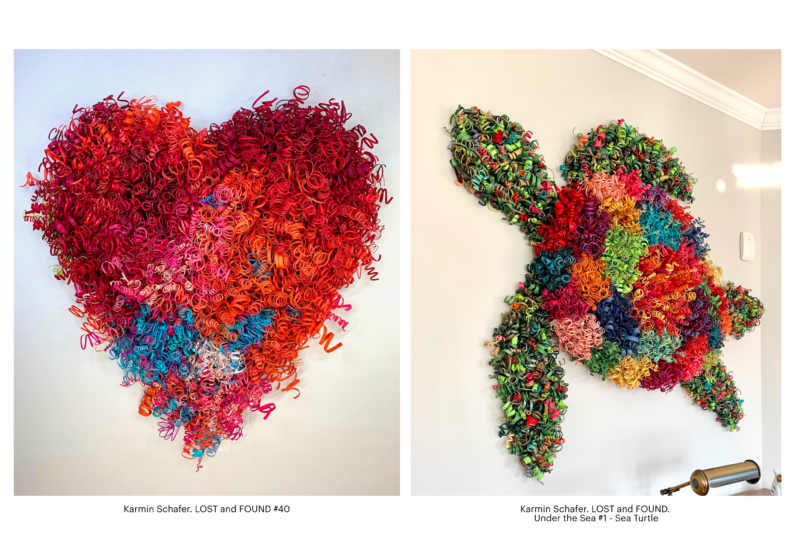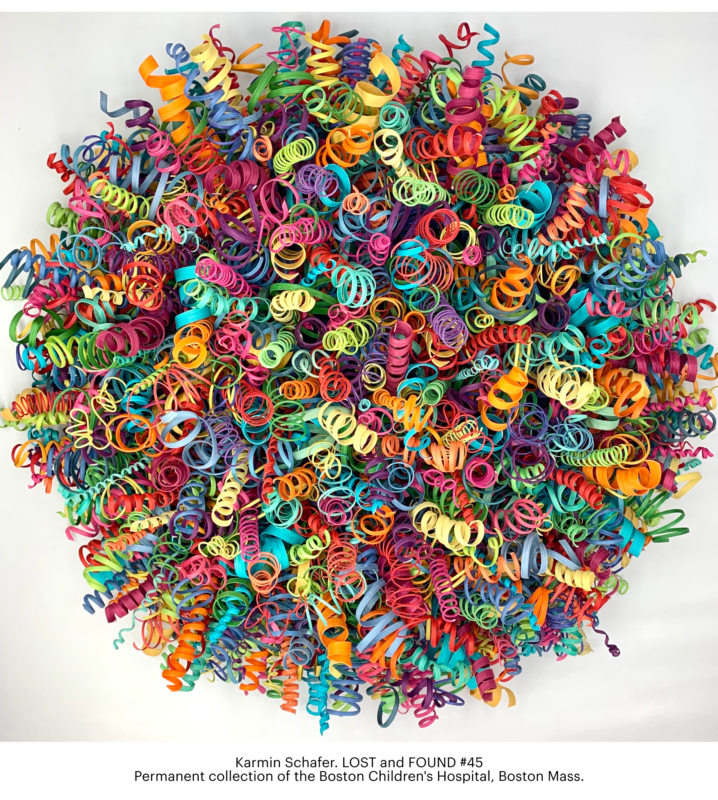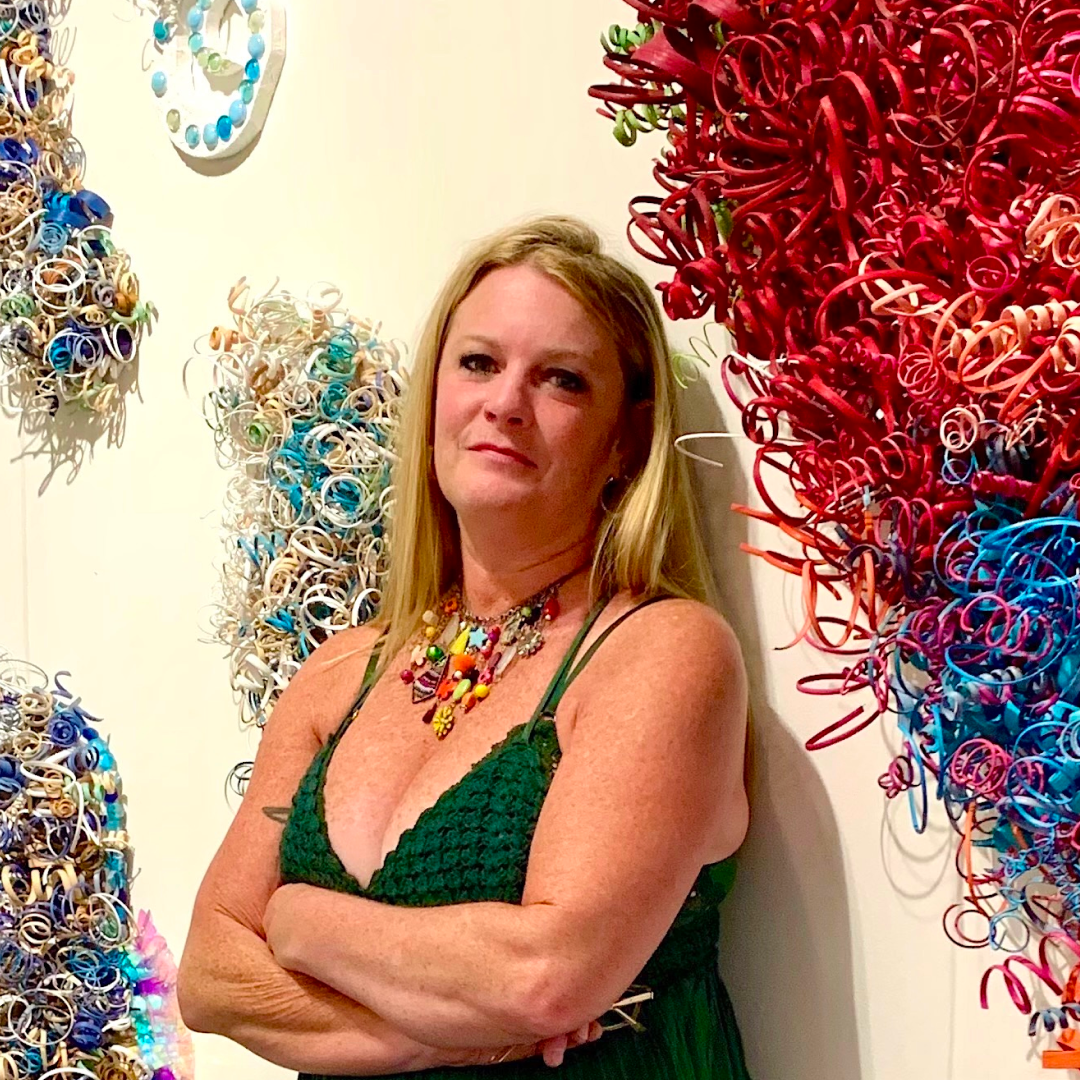Karmin Schafer Hansen crafts multi-layered, intricate sculptures using colored wood curls, employing a unique technique she conceived and has been perfecting for years. In an interview with Fine Art Shippers, Karmin shared the story behind her invention, some secrets of her art, and her passion for experimentation.
Artist Talk: Karmin Schafer on Taming Wood
Can you briefly talk about your artist journey that led you to where you are now?
Karmin Schafer: I pursued a painting degree in college, where I dedicated four years to painting and drawing. However, after graduation, I found that there weren't many job opportunities for painting and drawing majors. This meant I had to figure out how to find work and establish myself in the art world, which was a lengthy process. To have a steady income, I went back to school for a master's in art education. Contrary to what some may think, some teachers are also artists. I consider myself first an artist. Teaching is more of a side job for me now; I spend far more time on my art.
My career as an artist has developed gradually, starting with local art shows. The internet, which wasn’t available when I graduated and came later, has significantly expanded my opportunities, allowing me to share my art globally.
How did you come up with the idea of your signature wood curls sculptures?
One morning, I watched a renowned Irish woodcarver create a bowl. The way large spirals of wood flew off and scattered across the floor was mesmerizing. I was captivated—I grabbed my sketchbook and started sketching out idea after idea. Before that moment, my art had always been realistic. I had dabbled in abstraction somewhat, but never in sculpture or three-dimensional art. That experience completely changed my perception and vision of art.

Can you talk about the process of creating your wooden sculptures? It must be fascinating.
This process is quite time-consuming. I work with natural wood, similar to what's used for weaving baskets. A wonderful lady hand-dyes them for me. Each batch is slightly different, which allows me to get subtle variations within the same color, for example, different shades of dusty blue. I curl and twist each piece of wood by hand. When I assemble my sculptures, I carefully place each wood curl one at a time. I meticulously consider where each colored curl should be placed, making sure it's angled correctly and is the right size.
There are so many things I process in my mind with each sculpture. Each time, there’s a lot of creative problem-solving involved. I conduct extensive research and experiment to find what works best. For instance, since I can't get white dyed wood, for every white curl, I have to dip the wood in white paint, let it dry, and then curl it before assembling. This makes white an especially time-consuming color to work with.
How do you see your sculptures placed in a space? What kind of display works best for them?
Most of my pieces are wall-mounted. I've also made some that can be placed on a table, like centerpieces. And I have a larger piece that hangs like a chandelier. I'm always looking for new ways to display them in spaces. My goal now is to create a large outdoor metal sculpture. It's been about two years since I decided that I wanted to do this one day.
I’m curious about your teaching method. What do you think is the most important thing for your students to learn?
I always try to give my students as much opportunity as possible to use different art materials. In a school setting, some structure is necessary, so not every student can do exactly what they want. However, within the assignments, I offer a degree of creative freedom. I set guidelines, and then they take it from there. My focus is really on developing their problem-solving skills and encouraging them to make decisions independently. Nowadays, I've noticed that kids often look to teachers and adults to provide answers instead of thinking and figuring things out for themselves. I always encourage them to just try things. After all, what's the worst that can happen?
 On your website, there are a lot of photographs of your friends and family, one can see that you are very attached to them. How does your close circle influence your art?
On your website, there are a lot of photographs of your friends and family, one can see that you are very attached to them. How does your close circle influence your art?
My husband is incredibly supportive, I couldn’t ask for a better partner. He has taken on many household responsibilities, including caring for the kids, driving them around, cooking, and laundry, all to ensure that I have enough time for my art. He also assists me with my shows by handling many organizational aspects. I wouldn’t be where I am now in my art career without him. My daughters help me set up for shows too, which we sometimes turn into mini-vacations. While I’m occupied at the show, they enjoy time at the beach, or go explore the new location, and we catch up later.
I’m very grateful to my parents, who have always been incredibly supportive as well. They encouraged me to pursue a college degree in painting. My dad, who took up art later in life, often discusses art with me, which is truly wonderful.
I have fantastic friends who are always eager to know about my current projects and regularly attend my shows. Sometimes, I create sculptures as surprises simply to bring them joy. I believe that art is not just for sale, but also to make people happy.
Interview by Inna Logunova
Photo courtesy of Karmin Schafer
